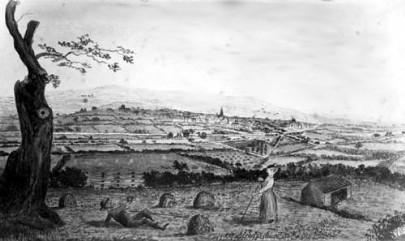History of the Lodge
THE HISTORY OF PHILANTHROPIC 304 LODGE OF FREEMASONS
To put the history of our lodge in historical context, it is useful to review what was happening in the world at the time of our foundation.
George III was on the throne of England, his government under the leadership of William Pitt.
Slavery was still permitted in Britain, and wouldn't be abolished for another 13 years
Our American colonies had gained their independence only 11 years earlier, and their civil war would not take place for another 67 years.
The French Revolution which had started only five years earlier was still in full swing, in fact Robespierre's reign of terror had only ended in the same year on which our lodge was founded. Napoleon also came to power in this year
India was a collection of Prince states, ruled by the Mogul Empire.
Europe was at that time awash with ideas of republicanism and an end to monarchies. All of which was fired up by the French Revolution
The British Empire was still in the distant future.
The first 150 years
Over two hundred years ago on Monday, August 25th 1794, Philanthropic Lodge held its inaugural meeting. Eight members of Fidelity Lodge, No 289, were responsible for our formation and to them we salute our Brethren in Fidelity in particular and to our Brethren in Freemasonry, in general with an exposition tracing our history, our achievements, and indeed our landmarks which point to the contribution Philanthropic Lodge has made to our ancient and honourable order.
If we could but summon those ancient Brethren from the Lodge above, what a dramatic story they would tell . . . what a truly inspiring story of their determination to extend the Craft here in Leeds, in what was most certainly a dark and dangerous age.
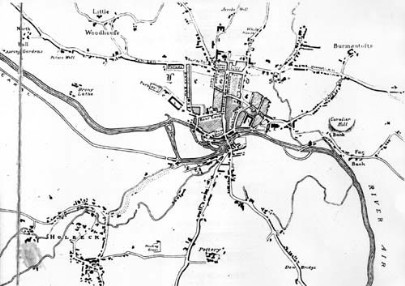
FIRST MINUTES of PHILANTHROPIC LODGE NO. 542
LEEDS, MONDAY, AUGUST 25TH 1794
Lodge opened at 8 o'clock when Brother Bentley was properly installed as Master and took the chair.
Brother Higgins as S.W., Brother Parish J.W., Brother Armatage Treasurer, Brother. Willcock Secretary, properly obligated Brother Joel and Brother Cocker as Deacons. Master installed by Worshipful past Master Sutcliffe in the presence of Brother Banks, Brother Craven, Brother Cock and Brother Boothman from the Lodge of Fidelity 512, Leeds.
Brother Craven proposed himself to become a member of this body. Brother Willcock proposed Joseph Dorrams to be initiated into Masonry and paid 5 shillings. Brother Bentley proposed Richard Constantine to be initiated into Masonry as Tyler and paid 5 shillings. Lodge closed at 11 o'clock in good harmony.
They met in a pub – there was nowhere else. It can’t have felt much like an historic occasion, a few men sitting in a smoky room in this pub, the Crown Inn, Kirkgate Leeds. It was lit, poorly lit, by tallow tapers.
We know it was a smoky room because three months later smoking in the Lodge was banned. Any Brother choosing to smoke must do so outside the Lodge – that’s what it says in the minutes.
And we know it was poorly lit by tallow tapers because they complained about them for two years, then the Senior Warden had something to say about ‘em, so they changed to wax candles.
Now we are not suggesting that our illustrious founders spent their Lodge nights putting up “No Smoking” signs and complaining about the light.
Our minutes tell us that those early meetings were closed in “Perfect Peace, Great Friendship and Great Harmony.”
But if the mood inside the Lodge was of peace, harmony and friendship, the atmosphere in the outside world was very different indeed,because England was at war.
Leeds one of the eight major cities of England was literally knee deep in the filth and squalor of the first waves of the Industrial Revolution.
England had declared war on France the year before. Volunteer armies were being raised in every town to counter the threat of insurrection and internal commotion.
The tide of war, the birth of the steam age, our people caught up in the Industrial Revolution and the Craft in Leeds undoubtedly, inevitably, at a low ebb.
These were the elements making up the turbulent times in which our Lodge was founded.
Most assuredly, Philanthropic Lodge needed Men of Fidelity. . .
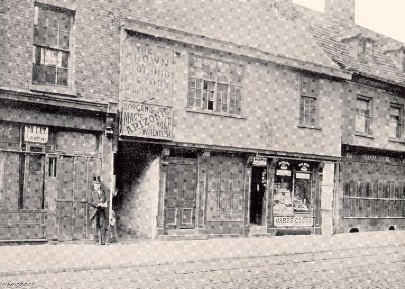
The Crown Inn, Leeds
Date not known, but probably late 19th or early 20th century (lodge archive)
We do not exaggerate the seriousness of the industrial and the economic climate of Leeds back in 1794.
We found this brief notice in a weekly newspaper, The Leeds Intelligencer, of May 12th, 1794, which was just a few months before our formation.
'Just published, price sixpence, a concise sketch of the intended revolution in England with a few hints on the obvious methods to avert it.'
In April, June and July of that same year the Leeds Intelligencer carried news about the many regiments being formed for the defence of the town in against what they describe as 'internal commotion.'
The same thing was happening at Bradford, Huddersfield, Halifax, Wakefield, Pontefract and York.
You may wonder why our founders should be so afraid of cowans and intruders.
They had good reason to be afraid because Philanthropic Lodge was born when the formation of secret societies was almost a growth industry.
These various societies were often quasi Masonic in the oaths which they took, in their terminology and in their initiation ceremonies.
They swore blood oaths on human skulls or bibles; they used hoodwinks, and they called each other Brother. Members often attended in disguise to guard against informers.
Of course, some of these societies were the forerunners of modern trade unions, others were self help, social benefit groups, better known as Benevolent Societies or Friendly Societies, such as the Ancient and Noble Order of Oddfellows.
But others were radical and republican, extremist groups which opposed England’s war with France. Understandably these militant bodies became the targets of a very hostile campaign waged against them by the authorities and they did not survive much beyond the turn of the century.
A secret society....? or a subversive society....? That was the question.
The following is a is part of a Luddite oath sworn by all new members of one of these societies around this period.
“ I, A.B., of my own voluntary will, do declare and solemnly swear, that I never will reveal to any person or persons under the canopy of heaven, the names of persons who compose this secret committee, their proceedings, meetings, places of abode, dress, features, complexion or anything else that might lead to a discovery of the same, either by word, deed or sign, under the penalty of being sent out of the world by the first Brother who shall meet me, and my name and character blotted out of existence, and never to be remembered but with contempt and abhorrence"
Note: When mechanisation first appeared, many tradesmen mainly spinners and weavers saw their living being threatened and took to smashing the new machinery. They were known as Luddites.
One of our less virtuous members was Brother Craven, whose appointment as treasurer at the beginning of 1795 brought discord.. distress.. and disunity to our Lodge.
It was an unfortunate episode, lasting eight months as the following minutes show:
March 25th: The chief part of the members was much dissatisfied respecting the behaviour of Brother Craven.
April 3rd: A Committee was appointed by the Master and Wardens concerning Brother Craven and Brother Pettinger.
April 13th: Brother Craven advanced many things with regard to Brother Pettinger having hurt him in his character by calling him a thief, etcetera .... which Brother Pettinger denied.
July 22nd:Brother Bentley moved that Brother Craven had said something respecting the Master ruling the Lodge in an arbitrary manner and he hoped that Brother Craven would stand forward and vindicate the same. Brother Craven said he did not remember saying anything as such, but if he did, he was blamable.
Lodge closed at ten o'clock.
August 19th: It was unanimously agreed that Brother Craven should be suspended for six months.
Lodge closed at ten o' clock....In Perfect Peace!
This affair was certainly a most severe blow to our Lodge. It says much for the character of the remaining members that Philanthropic Lodge weathered the storm.
This was the age in which our founders lived, an environment clearly hostile to the Craft and suspicious with some justification of any new or secret society.
An atmosphere, you may think, sorely in need of Brotherly Love, Relief & Truth.
What kind of men, then, were our founders? They were just ordinary men.
Our first Worshipful Master, James Bentley, was 32 years old, with just seven months in the Craft. Our Senior Warden, Henry Higgins, was 26, and had completed 22 months in Masonry, which was longer than any of our founders.
They were all Fellow Crafts, a situation which was resolved in March, 1795, when our minutes record that Brothers Bentley and Higgins should go to York for instructions in the third step of Masonry, “and that at the Lodge expense.”
They were just ordinary men, with ordinary men's virtues. and vices.
One event, which must have given our early Brethren cause for optimism, took place in May, 1799, a historic month for Masonry in England. It was at this time that most Masonic Lodges were declared to be exempt from a bill passed by Parliament suppressing secret societies. Once again, we turn to the files of the Leeds Intelligencer, dated May 27th, 1799, for confirmation of this important watershed in our Masonic history. Our founders were just ordinary men, with ordinary men's virtues and ordinary men's vices.
So our first year contained more than its share of discord and dishonourable conduct. But it was also marked by the initiation of a candidate who was later to be acknowledged as one of the giants of his time.
Four years later Philanthropic Lodge had the painful duty of expelling Worshipful Brother Bentley, its first Worshipful Master and Brother Joseph Dorrans, its first candidate, for being implicated in 'putting off' base silver.
This was, of course, a very serious offence usually involving the clipping of coins.
It was in connection with this incident that we found perhaps the saddest sentence in our minutes:
“The Lodge was closed in great sorrow on account of the wicked Brothers' conduct, but in peace and goodwill to the whole Craft in Masonry and mankind in general.”
Note: At that time, coins were made of precious metal, and the edges were clipped to remove some metal, leaving the coin still usable as legal tender. The practice was known as "coin clipping". A remedy to end this practice was to "knurl" the edges of the coin, is still used at the present day.
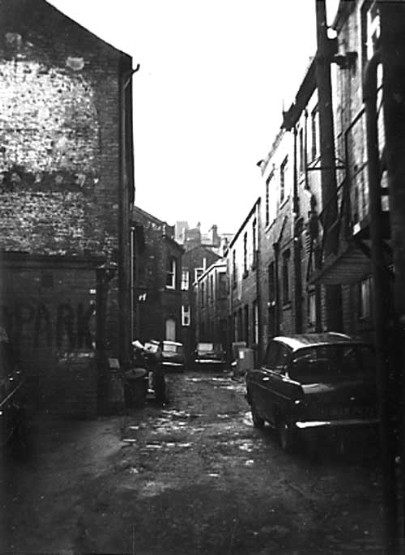
Hirst's Yard
Located on the east side of Briggate, just below the junction with Duncan Street, Hirst's Yard was named after William Hirst. He was born near Huddersfield and came to Leeds in 1795, where he set up in business as a cloth dresser.
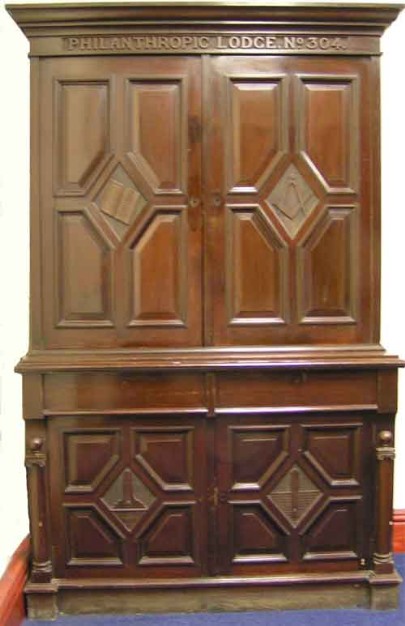
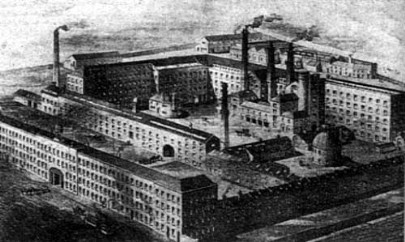
Carved Oak press belonging to Philanthropic Lodge
Gott's Mill, Leeds( http://www.leodis.net/_)
On February 11th, 1795, the Lodge initiated William Hirst,(1777-1858) a clothier who was one of the three men credited with the foundation of the Leeds clothing industry.
The others were Benjamin Gott (1762-1840) and Ralph Thoresby.
(Note: The famous Ralph Thoresby died in 1725, and could not have been the brother referred to in our archives, but the Thoresby family were well established in Leeds, and ours may well have been a descendant)
For the next few years Philanthropic Lodge charted a steady course, attracting candidates and joining Brothers who helped the Lodge to face the challenge of the 19th century with renewed optimism.
Men like the candidate initiated on March the 2nd, 1803. He was 40 years old, he was an iron founder and his name was.... MATTHEW MURRAY, the steam pioneer whose reputation as a locomotive engineer ranks with that of George Stephenson.
He was responsible for the worlds first railway, which was a private railway, unlike George Stevenson's later Stockton & Darlington railway which took passengers from the paying public.
http://www.leeds.gov.uk/armleymills/gallery/gallery1.html
By this time Philanthropic Lodge had also become established as a “Moon Lodge”, the term given to those Lodges whose antiquity pre dates street lighting and who, accordingly, timed their meetings to coincide with the full moon.
This important decision was taken on July 18th, 1798, when Brother Grainger moved that we should "have the Lodge night altered to the convenientest time having the benefit of the moon." By 1820 technology, in the shape of the Leeds Gas Company, had come to lighten our lives with the installation of 250 gas lamps in the centre of Leeds.
Most people welcomed the gas lamps … but there's always one dissenting voice.
One writer of the period condemned gas lamps as “a damnable way to dissipate God's darkness.”
As we said earlier, Philanthropic Lodge held its early meetings in pubs, although the choice was not always unanimous. On May 7th, 1801 our minutes note a resolution that the Lodge be removed to the house of Joseph Hindle, junior- this was the Talbot Inn.
Our worthy founders - at least those who had not been ... EXPELLED... SUSPENDED.... or had otherwise dishonoured the Craft were clearly determined to be far more selective when considering candidates.
Our minutes of May 23rd, 1804, note:
“From a further investigation of the character of Benjamin Townsley, and he at that time... being so much in liquid... that he caused a riot in the house, the Lodge thought proper to revoke their former ballot in favour of him and in consequence of which he was refused as an unworthy candidate for Masonry.”
Now, Benjamin Townsley can only have been unworthy or so much in liquid for one year because in 1805 he was initiated into Freemasonry in general... and Philanthropic Lodge in particular.

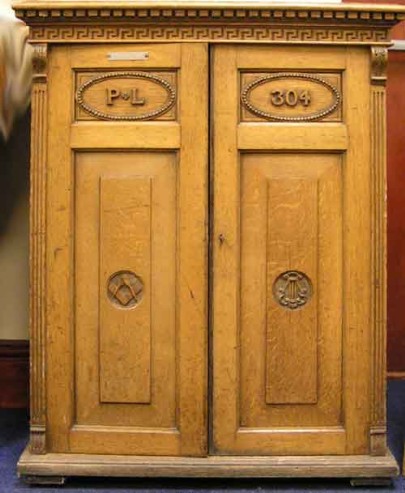
Gavels Presented to Philanthropic Lodge
We have identified our illustrious founders, we have acknowledged that some of them had their failings, and we have paid tribute to some of the eminent men who were bretheren of Philanthropic Lodge in its formative years.
We now turn to one man, David Kirkman, a past master whose determination and devotion to the Craft kept Philanthropic Lodge in existence more than 150 years ago when the fortunes of Philanthropic were without doubt at their lowest.
Worshipful Brother David Kirkman was installed in December, 1821, then occupied the chair on no less than six occasions up to 1834, during which time membership dwindled to seven (in 1830) and three (in 1832).
He was our Worshipful Master at the time of his death in 1834, by which time he had also initiated improvements which enabled Philanthropic Lodge to resume its place in the Masonic life of Leeds. He was our first Provincial officer, being promoted to P.P.G.D. in 1822.
David Kirkman was, unquestionably, the outstanding and the most influential figure in Philanthropic Lodge during its first fifty years.
A Victorian Cupboard owned by Philanthropic Lodge
Those first 50 years were given no special acknowledgement during 1844, our Golden Jubilee.
Perhaps our Brethren did not feel in a celebratory mood.
For they lived in a city, which in 50 years had trebled its population to more than 150,000 people, most of whom still lived in appalling squalor. Epidemics of cholera and typhus occasionally swept through the city, one of which culminated in a Government report in 1844.
Much of that report referred to the central area of Leeds, the area where Philanthropic Lodge held its regular meetings.
Imagine, then, the Brethren of Philanthropic Lodge making their way through a district which, to quote the Government report, had....
“Broken panes in every window, filth and vermin in every nook, the walls unwhitewashed for years and black with the smoke of foul chimneys, no water supply, no lavatories, sacking for bed clothing, and the refuse thrown in the street. Outside there are streets raised a foot, sometimes two, above the level of the causeway, by the accumulation of years of excreta.
An area undrained … unpaved ... unventilated ... uncared for by any authority but the landlord who weekly collects his miserable rents from his miserable tenants.”
And so we come to the next 50 years, the Golden Age of Victorian England, with Britain the greatest power in the world.
For Philanthropic Lodge it was to be 50 years of change and challenge.
After 70 years of meeting in pubs Philanthropic Lodge had its own Masonic Hall.
It was opened in 1865 and the original building is still standing at the back of Leeds Town Hall and adjoining the Victoria Hotel. When sold it eventually became a probation office and has now been fully renovated and now stands as a pub called The Irish Pub, 25 Great George Street.
Two years earlier, the Royal Arch Chapter of Philanthropic Lodge had been formed, before which time our Brethren had taken the Royal Arch degree, either in Fidelity or Alfred Chapters.
Those two events, the building of a Masonic Temple and the establishment of our own Chapter, restored Philanthropic Lodge to its former position in the Masonic life of Leeds.
Of course, Masonry is more about the quality of the Brethren … fabric of the building, no matter how ornate or impressive the temple may be.
In this respect Philanthropic Lodge had during this second 50 years the services of many eminent and distinguished Brethren, men whose achievements in commerce, industry, and public service ensure them of their own place in history.
Yet amongst these most worthy Brethren there is one man whose knowledge of Masonic ritual, whose contribution to Craft, Chapter and Research Lodges, earned him a very special niche in Freemasonry in general and Philanthropic Lodge in particular.
We are proud to mention Worshipful Brother the Reverend Adolphus Woodford, a joining Brother of Philanthropic. Master in 1856 and 1858, Grand Chaplain of England in 1863, who was acknowledged to be the leading figure of the founder members of Quator Coronati, the premier research Lodge, No 2076. He was the man who revised our ritual into the form now in use by Philanthropic and five other Leeds Lodges, Coronation (No 2922), Leodiensis (No 4029), Aurora (No 4047), Horsford (No 5339) and Morning Star (No 5362).
Adolphus Woodford was originally an officer in the Coldstream Guards who took holy orders on leaving the army. He was a Mason for 45 years, having been initiated into the Lodge of Friendship, Gibraltar, No 278, in 1842, also joining the Marquis of Granby Lodge, Durham, No 142, in the same year.
He became a joining member of Philanthropic in 1854 on his appointment to the living of Swillington, near Leeds.In 1863 he joined the Lodge of Antiquity and the same year he founded Philanthropic Chapter, of which he was the first principal in 1863 and again in 1864.
He was Provincial Grand Chaplain of Durham in 1847, Provincial Grand Chaplain of West Yorkshire in 1863 and, as mentioned earlier, Grand Chaplain of England in the same year.
Adolphus Woodford was a founder and the first chairman of the West Riding Charity Committee.
In addition he was editor of the journal, The Freemason, for a number of years.
Understandably, the membership of Philanthropic Lodge was at its highest during the years in which the Rev. Brother Woodford was most active. In fact, our membership rose to 90 in 1866.
We have also singled out one other member of Philanthropic Lodge during the Victorian period the Rev. Thomas Greenbury, who was initiated into our Lodge on July 14, 1875, and whose name will always be held in high esteem.
Although he never occupied the chair of King Solomon, he was Chaplain of our Lodge and at the time of his death in 1888 he was provincial Grand Chaplain of West Yorkshire.
The Rev. Brother Greenbury was a traveling agent for the Sailors' Orphan Home, Hull.
The next significant date in our history was, of course, our centenary, which took place on August 25th, 1894. It was an auspicious occasion, in the presence of the Provincial Grand Master, the Worshipful Brother the Right Honourable W.L Jackson, M.P., 41 officers of Grand and Provincial Grand Lodges, 44 Brethren and 75 visiting Worshipful Brethren and Brethren.
Among the many speeches made on such an important occasion one deserves special mention it was the response to the toast to the Masters and Brethren of the Leeds Lodges made by Worshipful Brother Arthur Butterworth, Master of Prudence Lodge, which was then the most junior Lodge in Leeds.
Prudence Lodge has never been listed as a daughter of Philanthropic Lodge, but this is how their own Worshipful Master acknowledged the bonds between his own Lodge and Philanthropic.
His words and they are recorded verbatim in our Centenary Book were:-
“I can assure you, Worshipful Master, that Lodge Prudence looks upon Lodge Philanthropic with a very deep affection, an affection which every child should have towards its mother, for had it not been for the support your Lodge extended, I doubt very much if Lodge Prudence would ever have been founded.”
We have not found the kind of documentary evidence which would confirm beyond doubt that Prudence is a daughter of Philanthropic but we would welcome the opportunity to examine any records or archives supporting the sincere belief that Prudence may be a daughter of Philanthropic
In 1906 the death occurred of Worshipful Brother F.H. Lawson, a stalwart of Philanthropic, and this led to a most remarkable entry in our Lodge history for that period.
This is the tribute paid to him after his death by the Worshipful Master, Worshipful Brother Charles Swann:
He suffered great agony during his last days on earth, but this was borne by him with true Christian fortitude and submission. He died as he had lived, full of ardour for Freemasonry,and with his last breath uttered those noble words of the Third Degree:
'When it has safely conducted us through the intricate windings of this mortal life, it finally teaches us how to die.'
He then fell peacefully asleep...
We would like to add that this worthy worshipful Brother initiated two of his sons into Philanthropic Lodge and that his grandson, Brother F.H. Lawson was initiated into this Lodge in 1919.
The Brethren of Philanthropic Lodge have pursued their Masonic interests and researches in many parts of the world, and indeed, in some most unusual locations.
In 1913, according to our Lodge history, Worshipful Brother John Barraclough, one of our past Masters, attended the July instruction Lodge where he gave an account of his visit to Australia.
The following note describes his talk:
“He stated how he came in contact with Freemasons on board ship on the outward journey, how he formed a Lodge, appointed his officers, and acted as Worshipful Master. The captain warmly encouraged the idea and afforded the Brethren every facility for gratifying their Masonic desires.”
As we said earlier, the first Leeds Masonic Hall, opened in 1865 at the back of Leeds Town Hall, still exists.
It appears, however, that by 1893 its upkeep had become too heavy a burden to bear.
Philanthropic Lodge resolved to sell the premises and this took place with the Lodges then meeting in the Carlton Hill Barracks area of Leeds.
Six years later Philanthropic Lodge, together with the other Leeds Lodges, raised the necessary money to build new premises in Great George Street and which were dedicated in July 1901in the presence of the Earl of Warwick.
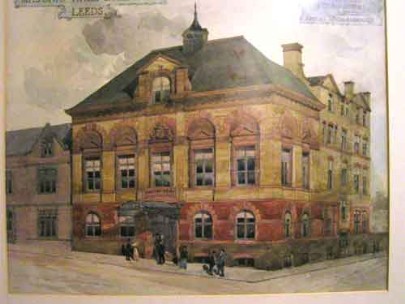
One year later Britain was at war. Fourteen Philanthropic Brethren served in the armed forces during the First World War. All of them returned safely home and we still have their discharge certificates in our archives.
Original architects illustration of the new Masonic building in George Street, Leeds
We would now like to recall the Philanthropic Children's Christmas Party of 1918 which, coming after four years of war, was obviously a very special occasion.
Our Lodge history says:
“The children's party deserved special mention. A large number attended and the arrangements worked splendidly... but the great feature was the visit of a troupe of performing geese, and a performing horse which went through their clever performance to the great delight of young and old.”
Now... this report does not say that the spectacle of a horse, climbing the stairs and bouncing about on the dance floor, brought the house down but perhaps the less said about that, the better.
Ten years later, in 1928, Britain was in the midst of a slump. It was during this year that our Lodge historian reported the receipt of a circular from Grand Lodge warning secretaries and almoners of Lodges to “exercise great caution in giving casual relief to persons who travel the country stating that they are poor and distressed Freemasons.”
The note continues.... “Many of these men are impostors, but as our almoner is the Chief Constable (Brother R.L. Matthews) no relief will be given unless the applicant is worthy of aid.”
In December 1936, Brother Norman Best was elected Worshipful Master, thus becoming the third "Lewis" of Philanthropic Lodge to occupy the chair of King Solomon. He brought his son Brian into the Lodge and he took the chair in 1965.
We have two Lewis's in the Lodge at this moment in time W.Bro Jonathan Jackson and W.Bro Iain Glass
Britain at War
A few years later, Britain was again at war and this time the impact was felt far more quickly than had been the case during the First World War.
Apart from the obvious restrictions on meetings and, of course, on the scale of the Festive Board, it was a time when sentiment had to be sacrificed on the altar of national interest.
One example will illustrate this:
Brethren who possessed Charity Jewels or other Masonic ornaments (other than the Centenary and Royal Arch Jewels) were recommended to hand them over to be melted down to help the country's resources. This was done in September 1940.
A few months later, on February 19, 1941, it was reported that the attendance at the instruction Lodge was affected by an Air Raid Warning which was sounded just before the time fixed for the meeting.
Our history records: “In spite of the tension which prevailed in the city, the Worshipful Master and 14 of the Brethren were present.”
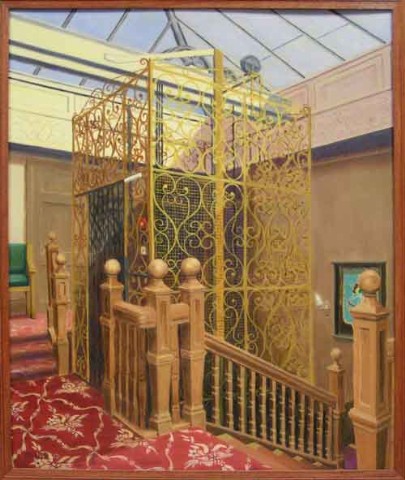
Painting of the lift in the interior at George Street.
Presented by artist R.Harrison
Leeds at War
In the Second World War, although a major industrial city, Leeds was not heavily bombed compared to some other cities. The main brunt of the blitz was taken by the ports London, Liverpool, Hull, Portsmouth etc. The centres of our manufacturing industry also had their share, significantly Sheffield and Coventry, the latter being almost destroyed in a single air raid.
Leeds did get bombed of course, but there were also frequent air raid alarms, usually around bedtime and everyone would get out of bed and go into their shelters. Whenever Hull was raided, and this was most nights, Leeds being only 40 miles away (not far for a bomber) was given an air raid warning just in case.
I have a personal recollection of this time. As a child I was taken outside by my parents to see "the chandeliers". These were magnesium flares on parachutes which were being dropped by German aircraft to illuminate the city for photographs. Our whole street was a bright as daylight and I recall an aircraft flying at very low level, presumably taking pictures. The following night, a Friday, they came back and Leeds had it's biggest air raid. All this was very exiting for a 6 year old, but my parents must have been terrified.
The time has now come for us to draw that mysterious veil over the prospect of futurity. We do so with the words spoken at our centenary in 1894 by the Right Worshipful the Provincial Grand Master, the Right Honourable W.L. Jackson, M.P., when presenting our Centenary Warrant:
He said:
“I give it to you in the earnest hope and wish that the Lodge may continue to prosper, that harmony will prevail, and that everything which tends to spread and to improve the order to which we have the honour to belong may ever be present in Philanthropic Lodge 304.”
Another note of around that period said: “A fairly heavy raid of German bombers was made on the centre of the city on March 14, 1941. Though damage was done to adjacent buildings we are thankful to report that the Masonic Hall received no injury.”
And so we come to the next great milestone in our history, August 25th, 1944, our 150th anniversary.
It was held under the distinguished patronage of the Provincial Grand Master, the Right Worshipful Brother Sir Anthony Gadie. He was accompanied by the Deputy Provincial Grand Master, nine other officers of Grand Lodge, 20 representatives of Provincial Grand Lodge, 16 Masters of Leeds Lodges and 60 visiting Brethren.
65 Brethren of Philanthropic Lodge were also present.
Our wartime historian noted at the time:
“during the after proceedings, 170 Brethren enjoyed a meal, as sumptuous as the present war restrictions permitted and great harmony prevailed.”
That occasion, the 150th anniversary of Philanthropic Lodge, celebrated both the influence and the contribution which the Brethren of Philanthropic Lodge have had and have made to the Craft at large and to Masonry in Leeds in particular.
The Lodge has existed over 200 years and we celebrated our Bi Centenary in style.
Numbers dictated that we held our Bi-Centenary at Castle Grove which is very coincidental, as that is where Fidelity, our founding Lodge, meet
We now hope you have enjoyed this exposition spanning three centuries.
We do not know what the future may hold.
But we can be confident that Just, Upright and Free men will continue to preserve the Craft in general and Philanthropic Lodge in particular.
